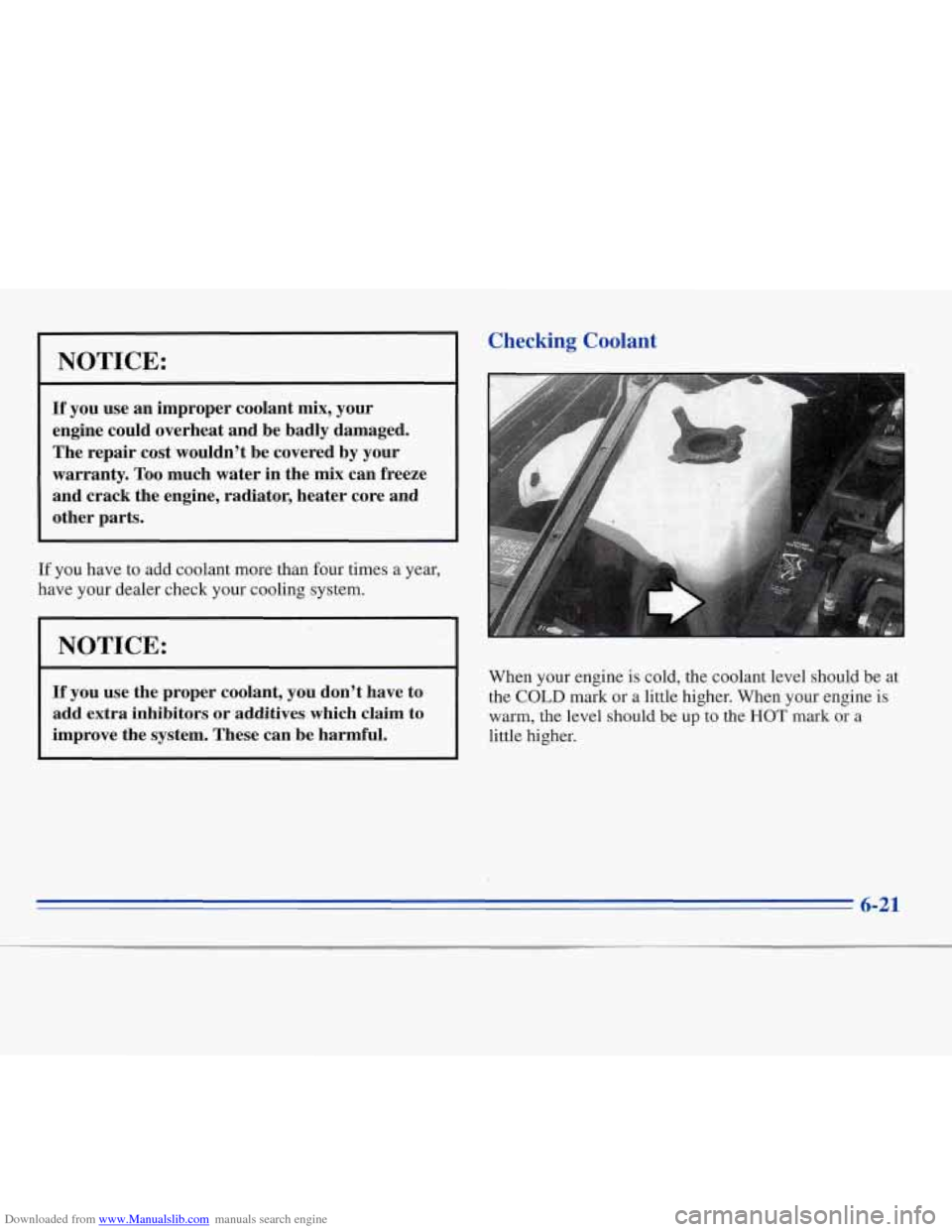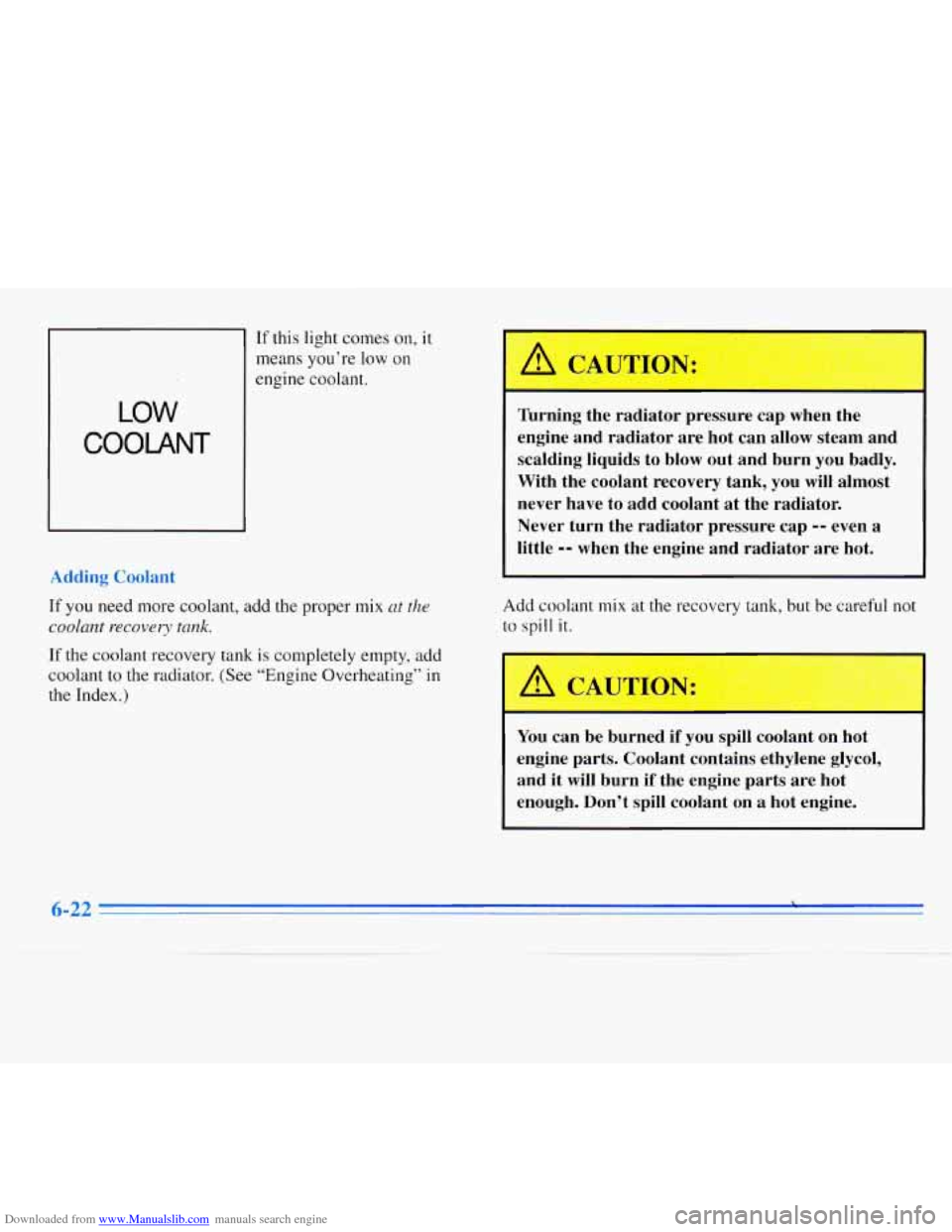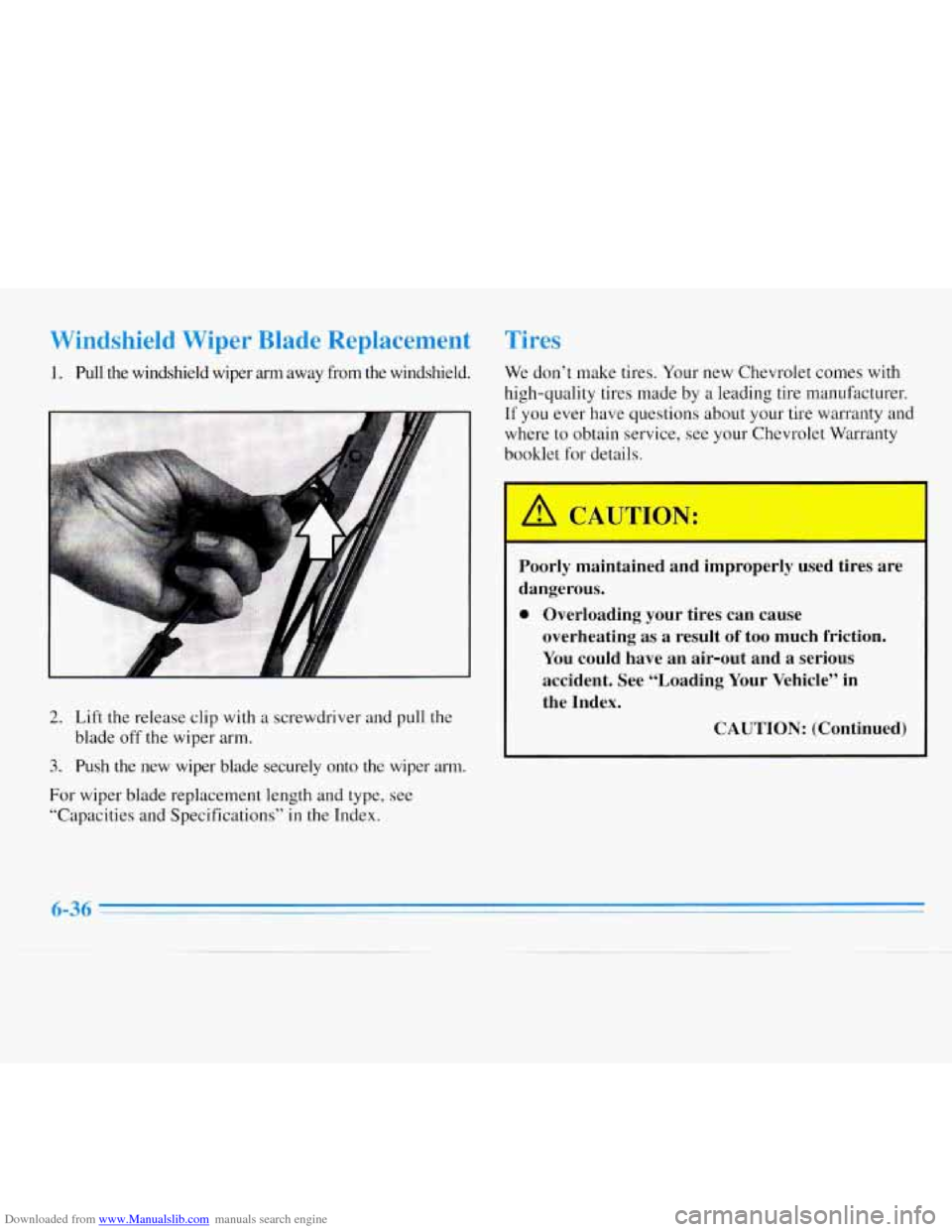1996 CHEVROLET MONTE CARLO engine overheat
[x] Cancel search: engine overheatPage 227 of 340

Downloaded from www.Manualslib.com manuals search engine How to Add Fluid Engine Coolant
Refer to the Maintenance Schedule to determine what
kind
of transaxle fluid to use. See “Recommended
Fluids and Lubricants”
in the Index.
If the fluid
level is low, add only enough of the proper
fluid to bring the level into the cross-hatched area on
the dipstick.
1. Pull out the dipstick.
2. Using a long-neck funnel, add enough fluid at the
dipstick hole to bring
it to the proper level. It doesn’t
take much fluid, generally less than
a pint (OSL).
Don ’t overfill. We recommend you use only fluid
labeled DEXRON@-111, because fluid with that
label is made especially for your automatic transaxle.
Damage caused by fluid other than DEXRON@-I11
is
not covered by your new vehicle warranty.
0 After adding fluid, recheck the fluid level as
described under “How to Check.”
0 When the correct fluid level is obtained, push the
dipstick back
in all the way. The cooling
system in your vehicle is filled with new
DEX-COOL
TM (orange-colored, silicate-free) engine
coolant. This coolant is designed
to remain in your
vehicle for
5 years or 100,000 miles ( 166 000 km),
whichever occurs first.
The following explains your cooling system and how
to
add coolant when it is low. If you have a problem with
engine overheating
or if you need to add coolant to your
radiator, see “Engine Overheating”
in the Index.
A 50/50 mixture of water and the proper coolant for
your Chevrolet will:
0 Give freezing protection down to -34°F (-37°C).
0 Give boiling protection up to 265°F (129°C).
Protect against rust and corrosion.
0 Help keep the proper engine temperature.
0 Let the warning lights and gages work as they
should.
Page 228 of 340

Downloaded from www.Manualslib.com manuals search engine NOTICE:
When adding coolant it is important that you use
DEX-COOL
TM (orange-colored, silicate-free)
coolant meeting
GM Specification 6277M.
If silicated coolant is added to the system,
premature engine, heater core or radiator
corrosion may result. In addition, the engine
coolant will require change sooner
-- at
30,000 miles (50 000 km) or 24 months
whichever occurs first.
What to
Use
Use a mixture of one-half clean water (preferably
distilled) and one-half
DEX-COOL TM (orange-colored,
silicate-free) antifreeze that meets
GM Specification
6277M, which won’t damage aluminum parts. Use
GM Engine Coolant Supplement (sealer) (GM Part
No. 3634621) with any complete coolant change. If you
use this mixture, you don’t need to add anything else.
Adding only plain water to your cooling system
can be dangerous. Plain water, or some other
liquid like alcohol, can boil before the proper
coolant mix will. Your vehicle’s coolant warning
system is set for the proper coolant mix. With
plain water or the wrong mix, your engine could
get too hot but you wouldn’t get the overheat
warning. Your engine could catch fire and you or
others could be burned.
Use a 50/50 mix of clean
water and DEX-COOL
TM (orange-colored,
silicate-free) antifreeze.
Page 229 of 340

Downloaded from www.Manualslib.com manuals search engine NOTICE:
If you use an improper coolant mix, your
engine could overheat and be badly damaged.
The repair cost wouldn’t be covered by your
warranty.
Too much water in the mix can freeze
and crack the engine, radiator, heater core and
other parts.
If you have to add coolant more than four times a year,
have your dealer check your cooling system.
I NOTICE:
If you use the proper coolant, you don’t have to
add extra inhibitors or additives which claim to
improve the system. These can be harmful.
Checking Coolant
r-
When your engine is cold, the coolant level should be at
the
COLD mark or a little higher. When .your engine is
warm,
the level should be up to the HOT mark or a
little higher.
6-21
Page 230 of 340

Downloaded from www.Manualslib.com manuals search engine LOW
COOLANT
If this light comes on, it
means you’re low on
engine coolant.
Adding Coolant
If you need more coolant, add the proper mix at the
coolant recovery tank.
If the coolant recovery tank is completely empty, add
coolant
to the radiator. (See “Engine Overheating” in
the Index.)
Thrning the radiator pressure cap when the
engine and radiator are hot can allow steam and
scalding liquids to blow out and burn you badly.
With the coolant recovery tank, you will almost
never have to add coolant at the radiator.
Never turn the radiator pressure cap
-- even a
little
-- when the engine and radiator are hot.
Add coolant mix at the recovery tank, but be careful not
to spill it.
A CAUTION:
You can be burned if you spill coolant on hot
engine parts. Coolant contains ethylene glycol,
and it will burn if the engine parts are hot
enough. Don’t spill coolant on a hot engine.
6-22 ,
Page 231 of 340

Downloaded from www.Manualslib.com manuals search engine Radiator Pressure Cap Power Steering Fluid
NOTICE:
Your radiator cap is a 15 psi (105 kPa)
pressure-type cap and must be tightly installed
to prevent coolant
loss and possible engine
damage from overheating. Be sure the arrows
on the cap line up with the overflow tube on
the radiator filler neck.
When you replace your radiator pressure cap, an AC@
cap is recommended.
Thermostat
Engine coolant temperature is controlled by a thermostat
in the engine coolant system. The thermostat stops the
flow of coolant through the radiator until the coolant
reaches a preset temperature.
When you replace your thermostat, an AC@ thermostat
is recommended.
3.1L L82 (Code M) Engine 3.4L LQI (Code X) Engine
When to Check Power Steering Fluid
It is not necessary to regularly check power steering
fluid unless you suspect there is a leak
in the system or
you hear an unusual noise. A fluid loss-in this system
could indicate a problem. Have the system inspected
and repaired.
6-23
Page 244 of 340

Downloaded from www.Manualslib.com manuals search engine Windshield Wiper Blade Replacement
1. Pull the windshield wiper arm away from the windshield.
r
2. Lift the release clip with a screwdriver and pull the
blade off the wiper arm.
3. Push the new wiper blade securely onto the wiper arm.
Tires
We don’t make tires. Your new Chevrolet comes with
high-quality tires made by a leading tire manufacturer.
If you ever have questions about your tire warranty and
where to obtain service, see your Chevrolet Warranty
booklet for details.
Poorly maintained and improperly used tires are
dangerous.
1
0 Overloading your tires can cause
overheating
as a result of too much friction.
You could have an air-out and a serious
accident. See “Loading Your Vehicle” in
the Index.
CAUTION: (Continued)
For wiper blade replacement length and type, see
”Capacities and Specifications”
in the Index.
6-36
Page 261 of 340

Downloaded from www.Manualslib.com manuals search engine Headlamp Wiring Fuses and Circuit Breakers
The headlamp wiring is protected by a circuit breaker in
the underhood electrical center. An electrical overload
will cause the lamps to
go on and off, or in some cases
to remain off. If this happens, have your headlamp
system checked right away.
Windshield Wipers
The windshield wiper motor is protected by a circuit
breaker and
a fuse. If the motor overheats due to heavy
snow, etc., the wiper will stop until the motor cools.
If
the overload is caused by some electrical problem,
have
it fixed.
Power Windows and Other Power Options
Circuit breakers in the fuse panel protect the power
windows and other power accessories. When the current
load is too heavy, the circuit breaker opens and closes,
protecting the circuit until the problem
is fixed. The
wiring circuits in your vehicle are protected
from short circuits by
a combination of fuses, circuit
breakers, and fusible thermal links
in the wiring itself.
This greatly reduces the chance
of fires caused by
electrical problems.
Look at the silver-colored band inside the fuse. If the
band is broken or melted, replace the fuse. Be sure you
replace
a bad fuse with a new one of the identical size
and rating.
--.
Instrument Panel Fuse Block
Page 331 of 340

Downloaded from www.Manualslib.com manuals search engine Console Storage ................................ 2-35
Control of a Vehicle
.............................. 4-5
Convenience Net
............................... 2-35
Convex Outside Mirror
.......................... 2-34
Coolant
....................................... 6-19
Bleedvalves ................................. 5-19
Heater. Engine ............................... 2- 12
Recovery Tank
............................... 5-16
Cooling System
................................ 5- I4
Courtesy Lamps
................................ 2-3 1
Courtesy Transportation ........................... 8-6
Cruise Control
................................. 2-27
Cupholders
.................................... 2-34
Customer Assistance for Text Telephone Users
......... 8-3
Customer Assistance Information ................... 8- I
Customer Satisfaction Procedure .................... 8- 1
Damage. Finish ............................... 6-50
Damage. Sheet Metal
............................ 6-50
Daytime Running Lamps
......................... 2-30
Dead Battery
................................... 5-2
Defects. Reporting Safety
......................... 8-8
Defensive Driving ............................... 4- 1
Defogger. Rear Window .......................... 3-4
Defrosting
..................................... 3-4
Dimensions. Vehicle
............................ 6-63
Dolby' B Noise Reduction
.................. 3-13. 3- 17
Storage Compartment
......................... 2-35
DoorLocks
..................................... 2-3
Drive Position. Automatic Transaxle
................ 2- 15
Driver Position ................................. 1 - 1 1
Driving Defogging
..................................... 3-4
City
........................................ 4-17 Defensive
.................................... 4-1
Drunken
..................................... 4-2
Freeway
.................................... 4-18
In a Blizzard
................................. 4-24
In Foreign Countries
........................... 6-3
In the Rain .................................. 4-15
Night
...................................... 4-13
OnCurves
................................... 4-8
On Grades While Towing a Trailer ............... 4-33
On Hill and Mountain Roads
.................... 4-21
On Snow and Ice ............................. 4-23
Through Water
............................... 4-17
WetRoads
.................................. 4-15
Winter
...................................... 4-22
With a Trailer
................................ 4-32
Drunken Driving
................................ 4-2
Electrical Equipment. Adding
.......... 2- I I. 3-2 1. 6-52
Electrical System
............................... 6-52
Electronic Climate Control
........................ 3-1
Engine 6-7.
6-8
Coolant
..................................... 6-19
Coolant Heater ............................... 2-12
Coolant Level Check .......................... 7-36
Coolant Temperature Gage
..................... 2-47
Coolant Temperature Light
..................... 2-46
Exhaust
..................................... 2-21
Identification
................................ 6-52
OilLevelCheck
.............................. 7-36
Overheating
................................. 5-12
Running While Parked ......................... 2-22
Specifications ................................ 6-62
Starting Your
................................ 2-11